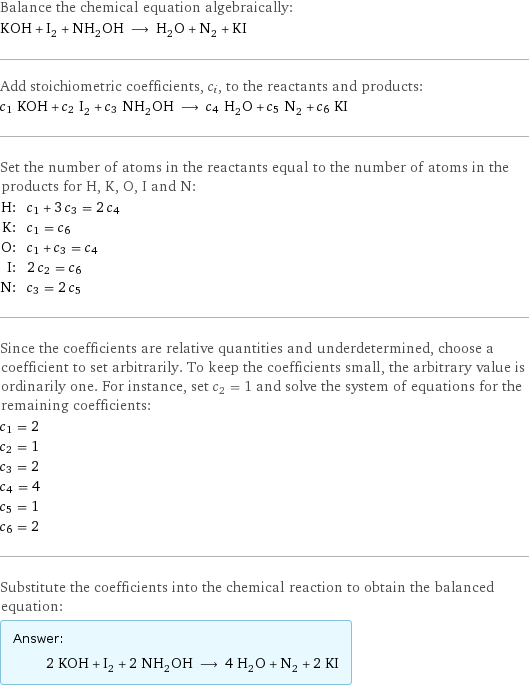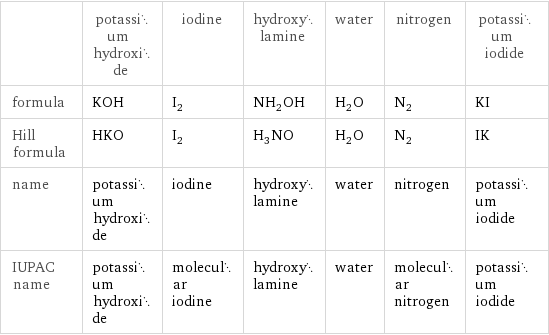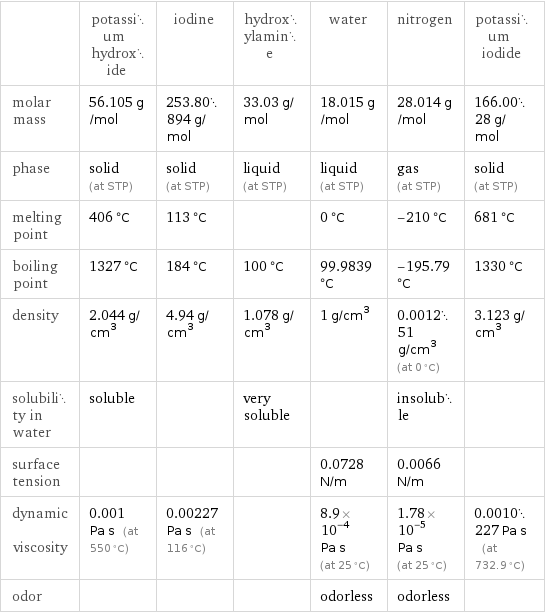Input interpretation

KOH potassium hydroxide + I_2 iodine + NH_2OH hydroxylamine ⟶ H_2O water + N_2 nitrogen + KI potassium iodide
Balanced equation

Balance the chemical equation algebraically: KOH + I_2 + NH_2OH ⟶ H_2O + N_2 + KI Add stoichiometric coefficients, c_i, to the reactants and products: c_1 KOH + c_2 I_2 + c_3 NH_2OH ⟶ c_4 H_2O + c_5 N_2 + c_6 KI Set the number of atoms in the reactants equal to the number of atoms in the products for H, K, O, I and N: H: | c_1 + 3 c_3 = 2 c_4 K: | c_1 = c_6 O: | c_1 + c_3 = c_4 I: | 2 c_2 = c_6 N: | c_3 = 2 c_5 Since the coefficients are relative quantities and underdetermined, choose a coefficient to set arbitrarily. To keep the coefficients small, the arbitrary value is ordinarily one. For instance, set c_2 = 1 and solve the system of equations for the remaining coefficients: c_1 = 2 c_2 = 1 c_3 = 2 c_4 = 4 c_5 = 1 c_6 = 2 Substitute the coefficients into the chemical reaction to obtain the balanced equation: Answer: | | 2 KOH + I_2 + 2 NH_2OH ⟶ 4 H_2O + N_2 + 2 KI
Structures

+ + ⟶ + +
Names

potassium hydroxide + iodine + hydroxylamine ⟶ water + nitrogen + potassium iodide
Equilibrium constant
![Construct the equilibrium constant, K, expression for: KOH + I_2 + NH_2OH ⟶ H_2O + N_2 + KI Plan: • Balance the chemical equation. • Determine the stoichiometric numbers. • Assemble the activity expression for each chemical species. • Use the activity expressions to build the equilibrium constant expression. Write the balanced chemical equation: 2 KOH + I_2 + 2 NH_2OH ⟶ 4 H_2O + N_2 + 2 KI Assign stoichiometric numbers, ν_i, using the stoichiometric coefficients, c_i, from the balanced chemical equation in the following manner: ν_i = -c_i for reactants and ν_i = c_i for products: chemical species | c_i | ν_i KOH | 2 | -2 I_2 | 1 | -1 NH_2OH | 2 | -2 H_2O | 4 | 4 N_2 | 1 | 1 KI | 2 | 2 Assemble the activity expressions accounting for the state of matter and ν_i: chemical species | c_i | ν_i | activity expression KOH | 2 | -2 | ([KOH])^(-2) I_2 | 1 | -1 | ([I2])^(-1) NH_2OH | 2 | -2 | ([NH2OH])^(-2) H_2O | 4 | 4 | ([H2O])^4 N_2 | 1 | 1 | [N2] KI | 2 | 2 | ([KI])^2 The equilibrium constant symbol in the concentration basis is: K_c Mulitply the activity expressions to arrive at the K_c expression: Answer: | | K_c = ([KOH])^(-2) ([I2])^(-1) ([NH2OH])^(-2) ([H2O])^4 [N2] ([KI])^2 = (([H2O])^4 [N2] ([KI])^2)/(([KOH])^2 [I2] ([NH2OH])^2)](../image_source/a81bf2689edce1bae15fe28cbbe06c90.png)
Construct the equilibrium constant, K, expression for: KOH + I_2 + NH_2OH ⟶ H_2O + N_2 + KI Plan: • Balance the chemical equation. • Determine the stoichiometric numbers. • Assemble the activity expression for each chemical species. • Use the activity expressions to build the equilibrium constant expression. Write the balanced chemical equation: 2 KOH + I_2 + 2 NH_2OH ⟶ 4 H_2O + N_2 + 2 KI Assign stoichiometric numbers, ν_i, using the stoichiometric coefficients, c_i, from the balanced chemical equation in the following manner: ν_i = -c_i for reactants and ν_i = c_i for products: chemical species | c_i | ν_i KOH | 2 | -2 I_2 | 1 | -1 NH_2OH | 2 | -2 H_2O | 4 | 4 N_2 | 1 | 1 KI | 2 | 2 Assemble the activity expressions accounting for the state of matter and ν_i: chemical species | c_i | ν_i | activity expression KOH | 2 | -2 | ([KOH])^(-2) I_2 | 1 | -1 | ([I2])^(-1) NH_2OH | 2 | -2 | ([NH2OH])^(-2) H_2O | 4 | 4 | ([H2O])^4 N_2 | 1 | 1 | [N2] KI | 2 | 2 | ([KI])^2 The equilibrium constant symbol in the concentration basis is: K_c Mulitply the activity expressions to arrive at the K_c expression: Answer: | | K_c = ([KOH])^(-2) ([I2])^(-1) ([NH2OH])^(-2) ([H2O])^4 [N2] ([KI])^2 = (([H2O])^4 [N2] ([KI])^2)/(([KOH])^2 [I2] ([NH2OH])^2)
Rate of reaction
![Construct the rate of reaction expression for: KOH + I_2 + NH_2OH ⟶ H_2O + N_2 + KI Plan: • Balance the chemical equation. • Determine the stoichiometric numbers. • Assemble the rate term for each chemical species. • Write the rate of reaction expression. Write the balanced chemical equation: 2 KOH + I_2 + 2 NH_2OH ⟶ 4 H_2O + N_2 + 2 KI Assign stoichiometric numbers, ν_i, using the stoichiometric coefficients, c_i, from the balanced chemical equation in the following manner: ν_i = -c_i for reactants and ν_i = c_i for products: chemical species | c_i | ν_i KOH | 2 | -2 I_2 | 1 | -1 NH_2OH | 2 | -2 H_2O | 4 | 4 N_2 | 1 | 1 KI | 2 | 2 The rate term for each chemical species, B_i, is 1/ν_i(Δ[B_i])/(Δt) where [B_i] is the amount concentration and t is time: chemical species | c_i | ν_i | rate term KOH | 2 | -2 | -1/2 (Δ[KOH])/(Δt) I_2 | 1 | -1 | -(Δ[I2])/(Δt) NH_2OH | 2 | -2 | -1/2 (Δ[NH2OH])/(Δt) H_2O | 4 | 4 | 1/4 (Δ[H2O])/(Δt) N_2 | 1 | 1 | (Δ[N2])/(Δt) KI | 2 | 2 | 1/2 (Δ[KI])/(Δt) (for infinitesimal rate of change, replace Δ with d) Set the rate terms equal to each other to arrive at the rate expression: Answer: | | rate = -1/2 (Δ[KOH])/(Δt) = -(Δ[I2])/(Δt) = -1/2 (Δ[NH2OH])/(Δt) = 1/4 (Δ[H2O])/(Δt) = (Δ[N2])/(Δt) = 1/2 (Δ[KI])/(Δt) (assuming constant volume and no accumulation of intermediates or side products)](../image_source/c876ec9a450c50be603d35b96a7b849e.png)
Construct the rate of reaction expression for: KOH + I_2 + NH_2OH ⟶ H_2O + N_2 + KI Plan: • Balance the chemical equation. • Determine the stoichiometric numbers. • Assemble the rate term for each chemical species. • Write the rate of reaction expression. Write the balanced chemical equation: 2 KOH + I_2 + 2 NH_2OH ⟶ 4 H_2O + N_2 + 2 KI Assign stoichiometric numbers, ν_i, using the stoichiometric coefficients, c_i, from the balanced chemical equation in the following manner: ν_i = -c_i for reactants and ν_i = c_i for products: chemical species | c_i | ν_i KOH | 2 | -2 I_2 | 1 | -1 NH_2OH | 2 | -2 H_2O | 4 | 4 N_2 | 1 | 1 KI | 2 | 2 The rate term for each chemical species, B_i, is 1/ν_i(Δ[B_i])/(Δt) where [B_i] is the amount concentration and t is time: chemical species | c_i | ν_i | rate term KOH | 2 | -2 | -1/2 (Δ[KOH])/(Δt) I_2 | 1 | -1 | -(Δ[I2])/(Δt) NH_2OH | 2 | -2 | -1/2 (Δ[NH2OH])/(Δt) H_2O | 4 | 4 | 1/4 (Δ[H2O])/(Δt) N_2 | 1 | 1 | (Δ[N2])/(Δt) KI | 2 | 2 | 1/2 (Δ[KI])/(Δt) (for infinitesimal rate of change, replace Δ with d) Set the rate terms equal to each other to arrive at the rate expression: Answer: | | rate = -1/2 (Δ[KOH])/(Δt) = -(Δ[I2])/(Δt) = -1/2 (Δ[NH2OH])/(Δt) = 1/4 (Δ[H2O])/(Δt) = (Δ[N2])/(Δt) = 1/2 (Δ[KI])/(Δt) (assuming constant volume and no accumulation of intermediates or side products)
Chemical names and formulas

| potassium hydroxide | iodine | hydroxylamine | water | nitrogen | potassium iodide formula | KOH | I_2 | NH_2OH | H_2O | N_2 | KI Hill formula | HKO | I_2 | H_3NO | H_2O | N_2 | IK name | potassium hydroxide | iodine | hydroxylamine | water | nitrogen | potassium iodide IUPAC name | potassium hydroxide | molecular iodine | hydroxylamine | water | molecular nitrogen | potassium iodide
Substance properties

| potassium hydroxide | iodine | hydroxylamine | water | nitrogen | potassium iodide molar mass | 56.105 g/mol | 253.80894 g/mol | 33.03 g/mol | 18.015 g/mol | 28.014 g/mol | 166.0028 g/mol phase | solid (at STP) | solid (at STP) | liquid (at STP) | liquid (at STP) | gas (at STP) | solid (at STP) melting point | 406 °C | 113 °C | | 0 °C | -210 °C | 681 °C boiling point | 1327 °C | 184 °C | 100 °C | 99.9839 °C | -195.79 °C | 1330 °C density | 2.044 g/cm^3 | 4.94 g/cm^3 | 1.078 g/cm^3 | 1 g/cm^3 | 0.001251 g/cm^3 (at 0 °C) | 3.123 g/cm^3 solubility in water | soluble | | very soluble | | insoluble | surface tension | | | | 0.0728 N/m | 0.0066 N/m | dynamic viscosity | 0.001 Pa s (at 550 °C) | 0.00227 Pa s (at 116 °C) | | 8.9×10^-4 Pa s (at 25 °C) | 1.78×10^-5 Pa s (at 25 °C) | 0.0010227 Pa s (at 732.9 °C) odor | | | | odorless | odorless |
Units
